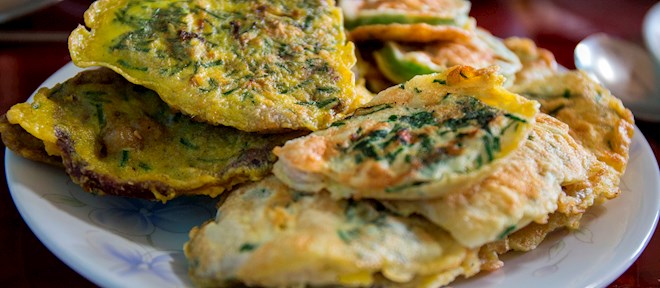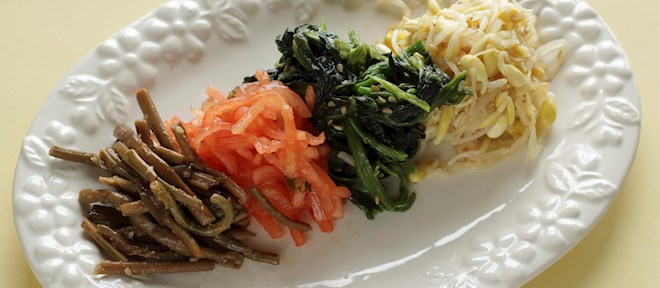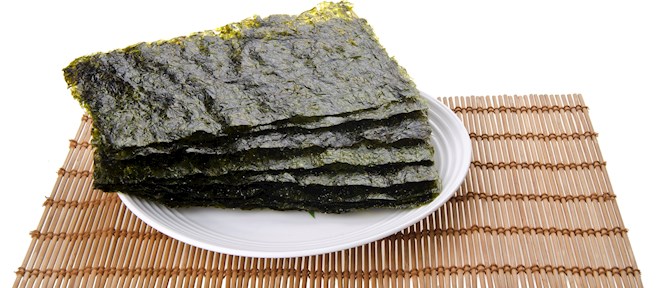Korean Side Dishes
& producers

No results.
Try changing the search filters.Korean Side Dishes

Jeon
Jeon, also known as Korean pancakes, represents a number of pancake-like dishes in Korean cuisine that are often served as appetizers, side dishes, or consumed as snacks. Although jeon are typically prepared in savory versions, there are ... READ MORE
Namul
Namul is a widely accepted term used to refer to Korean vegetable side dishes, which can include green leafy vegetables, starchy root varieties, sprouts, green beans, and occasionally even fruit. The ingredients are used in raw, pickled, fried, sa... READ MORE
Gim gui
Gim gui is a simple, yet delicious Korean side dish consisting of crispy and salty roasted seaweed. The dish is a common item in numerous bento boxes due to its great flavor and hefty doses of fiber, vitamins, minerals, and protein. Many people li... READ MORE
Geotjeori
Geotjeori is a fresh variety of kimchi. Just like classic kimchi, it is usually prepared with napa cabbage (baechu), but unlike the more popular version, geotjeori is not fermented. It is typically made with tender and salted cabbage leav... READ MORE
Kimchijeon
In its simplest form, this South Korean pancake incorporates sliced kimchi, preferably ripe version, with a simple flour batter. The dish belongs to a wide group of jeon—savory Korean pancakes—and it is easily adapted with various ingr... READ MORE
Kongnamul muchim
Seasoned soybean sprouts are a classic side dish in traditional Korean cuisine. The sprouts are rinsed and shortly cooked, but should remain firm and crispy. They are then mixed with various ingredients which typically include soy sauce, scallions... READ MORE
Gamjajeon
Gamjajeon is a type of Korean pancake prepared with grated or puréed potatoes, while some varieties may include scallions, chives, carrots, or onions. The pancakes are usually small and round and should be pan-fried until perfectly crispy o... READ MORE
Stir-Fried Octopus (Nakji bokkeum)
Stir-fried octopus is a classic Korean banchan (side dish). It is usually prepared with a small-sized octopus that is sliced and then fried in a flavorful combination of garlic, ginger, and gochujang chili paste, while other addi... READ MORE
Sigeumchi namul
Sigeumchi namul or shigeunchi is a traditional side dish originating from South Korea. This type of namul is prepared with spinach as the key ingredient. The spinach is blanched until slightly crispy and tender. It is then strained and mixed with ... READ MORE
Musaengchae
Musaengchae is a traditional side dish (banchan) originating from South Korea. This type of namul is prepared with Korean radish as key ingredient. The radishes are peeled and cut into matchsticks, then seasoned with salt and mixed with a combinat... READ MORE
Beondegi
Beondegi is a classic South Korean street food consisting of silkworm pupae insects. These tiny animals are usually boiled or steamed and then seasoned before they are served in small cups. Although of an acquired taste, beondegi is available at n... READ MORE
Saengchae
Saengchae is a Korean term used to denote various salads made with sliced fresh vegetables that are coated in a spicy dressing. The most common variety of the dish is made with sliced daikon radish (mu), but cucumber saengchae is also popular, as ... READ MORE
Sukjunamul
Sukjunamul is a traditional side dish (banchan) originating from South Korea. This type of namul is prepared with mung bean sprouts as key ingredients. The mung bean sprouts are rinsed and blanched until slightly soft, then drained and tossed with... READ MORE
Gaji namul
Gaji namul is a traditional side dish originating from South Korea. This type of namul is prepared with a combination of eggplants, garlic, scallions, soy sauce, sugar, sesame oil, sesame seeds, red pepper flakes, and black pepper. The eggplants a... READ MORE
Jeonggwa
Jeonggwa is a vast group of Korean-style confectionery that is usually prepared with seeds, sliced fruits, vegetable stems, or roots. The slices are typically doused in sugar or honey-based syrup and are then left to dry until they achieve their c... READ MORE
Kongjaban
Kongjaban is a traditional side dish (banchan) originating from South Korea. This type of namul is made with black soybeans as key ingredients. The black soybeans are first washed, soaked, and boiled in a combination of soy sauce and sugar until s... READ MORE
Buseot bokkeum
Buseot bokkeum is a South Korean side dish (banchan) that is made with stir-fried mushrooms. It is typically made with oyster, shiitake, or button mushrooms, but the choice is optional. The preparation starts with sliced mushrooms that are usually... READ MORE
Kkaennip-jeon
This South Korean dish consists of ground beef that is wrapped with perilla leaves (kkaennip), and the parcels are then coated with flour and egg wash before they are pan-fried. The filling is usually seasoned and enriched with scallions, garlic, ... READ MORE
Ojingeo chae bokkeum
This popular Korean snack consists of thin strips of dried squid (ojingeo chae) that are stir-fried together with gochujang-based chili paste and various additions such as garlic, soy sauce, or rice wine. The spicy snack is often served a... READ MORE
Korean Corn Cheese
Corn cheese is a traditional drinking snack (anju) and side dish originating from South Korea. The dish is usually made with a combination of fresh corn kernels, mozzarella, mayonnaise, butter, sugar, salt, pepper, and scallions. The ingredients a... READ MORE
Fermented Squid (Ojingeojeot)
Ojingeojeot is a traditional squid-based dish originating from South Korea. This preserved squid side dish is usually made with a combination of squid, salt, gochugaru pepper flakes, fish sauce, scallions, garlic, ginger, hot peppers, toasted sesa... READ MORE
Hobak namul
Hobak namul is a traditional side dish originating from South Korea. This version of namul is made with zucchini as key ingredients. Although regular zucchini can be used, it's recommended to use aehobak or Korean zucchini, if available, because i... READ MORE
Garaetteok
Garaetteok are long, cylindrical Korean rice cakes that are usually cut diagonally into smaller round discs. Although they can be enjoyed on their own, because of their neutral flavor, the cakes are easily incorporated into various dishes. The sli... READ MORE
Braised Potatoes (Gamja jorim)
Gamja jorim is a traditional South Korean dish of braised potatoes. Although there are many variations, the dish is usually made with a combination of potatoes, soy sauce, garlic, vegetable oil, sesame oil, sugar, black pepper, and hot peppers. Th... READ MORE
Braised Tofu (Dubu jorim)
Dubu jorim is a traditional South Korean dish consisting of braised tofu. The dish is usually made with a combination of firm tofu, soy sauce, honey, garlic, onions, hot peppers, gochugaru, anchovy stock (anchovies, kelp, and water), and toasted s... READ MORE
Korean Potato Salad (Gamjasaelleodeu)
Gamjasaelleodeu is a traditional potato salad originating from South Korea. Although there are many variations, the salad is usually made with a combination of potatoes, carrots, cucumbers, onions, hard-boiled eggs, Fuji apples, mayonnaise (Kewpie... READ MORE
Gochujang-Beef Stir-Fry (Gochujang bokkeum)
Gochujang bokkeum is a traditional dish originating from South Korea. The dish is usually made with a combination of gochujang (hot pepper paste), ground beef, pine nuts, sesame oil, garlic, sugar, and black pepper. The ground beef is seasoned wit... READ MORE
Stir-Fried Anchovies (Myeolchi bokkeum)
Myeolchi bokkeum is a traditional South Korean stir-fry. The dish is made with a combination of dried anchovies, gochujang hot pepper paste, garlic, sesame seeds, soy sauce, sesame oil, vegetable oil, and sugar. The anchovies are stir-fried in hot... READ MORE
Candied Sweet Potatoes (Goguma mattang)
Goguma mattang is a traditional sweet treat and side dish originating from South Korea. It's usually made with a combination of sweet potatoes, honey, sugar, oil, and walnuts. The sweet potatoes are cut into cubes, steamed, and deep-fried in oil u... READ MORE
Stir-Fried Cucumbers (Oi bokkeum)
Oi bokkeum is a traditional side dish originating from South Korea. The dish is usually made with a combination of thinly sliced cucumbers, sesame oil, sesame seeds, garlic, oil, salt, and pepper. The cucumber slices are tossed with salt, drained,... READ MORE
Stir-Fried Kelp (Dassima-bokkeum)
Dassima-bokkeum is a traditional South Korean dish of stir-fried kelp. The dish is usually made with a combination of kelp, garlic, onions, soy sauce, oil, and sugar. The kelp is cooked in vegetable stock and cut into squares before it's stir-frie... READ MORE







